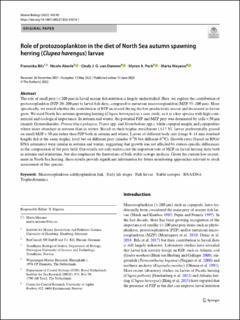Role of protozooplankton in the diet of North Sea autumn spawning herring (Clupea harengus) larvae
Peer reviewed, Journal article
Published version
Permanent lenke
https://hdl.handle.net/11250/3022110Utgivelsesdato
2022Metadata
Vis full innførselSamlinger
Originalversjon
Bils, F., Aberle-Malzahn, N., Van Damme, C. J. G., Peck, M. A. & Moyano, M. (2022). Role of protozooplankton in the diet of North Sea autumn spawning herring (Clupea harengus) larvae. Marine Biology, 169 (7), 1-16. doi: 10.1007/s00227-022-04076-1Sammendrag
The role of small prey (<200 µm) in larval marine fsh nutrition is largely understudied. Here, we explore the contribution of protozooplankton (PZP 20–200 µm) to larval fsh diets, compared to metazoan microzooplankton (MZP 55–200 µm). More specifcally, we tested whether the contribution of PZP increased during the low productivity season and decreased as larvae grow. We used North Sea autumn spawning herring (Clupea harengus) as a case study, as it is a key species with high commercial and ecological importance. In autumn and winter, the potential PZP and MZP prey was dominated by cells<50 µm (mainly Gymnodiniales, Pronoctiluca pelagica, Tripos spp. and Strombidium spp.), while copepod nauplii and copepodites where more abundant in autumn than in winter. Based on their trophic enrichment (∆15 N), larvae preferentially grazed on small MZP<50 µm rather than PZP both in autumn and winter. Larvae of diferent body size (range 8–14 mm standard length) fed at the same trophic level but on diferent prey (similar δ15N but diferent δ13C). Growth rates (based on RNA/ DNA estimates) were similar in autumn and winter, suggesting that growth was not afected by station-specifc diferences in the composition of the prey feld. Our results not only underscore the important role of MZP on larval herring diets both in autumn and wintertime, but also emphasize the limitations of bulk stable isotope analysis. Given the current low recruitment in North Sea herring, these results provide signifcant information for future monitoring approaches relevant to stock assessment of this species.

